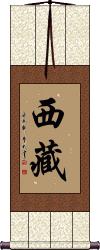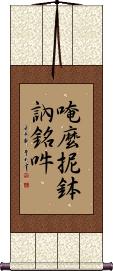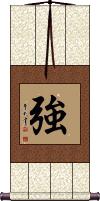Many custom options...
And formats...

Tibet in Chinese / Japanese...
Buy a Tibet calligraphy wall scroll here!
Personalize your custom “Tibet” project by clicking the button next to your favorite “Tibet” title below...
Tibet
西藏 is the Chinese and Japanese name for Tibet.
It is a vast area in southwest China for which the Chinese government has little control (except in the capital of Llasa). During your travels in Tibet (outside of Llasa) you will find it is rough country full of ruthless bandits and honorable and upright Living Buddhas. There are about 2000 Living Buddhas in Tibet, and at least 10 times more bandits ready to ambush you on the road or trail.
On the eastern frontier of Tibet, you will find the place designated to be Shangri-la. It's a friendly village of Tibetans and is the gateway to greater Tibet.
The full official Chinese name is Tibet Autonomous Region or 西藏自治區|西藏自治区. The name here, 西藏 is quite old - from several dynasties ago.
Nepal
Om Mani Padme Hum
Oṃ maṇi padme hūṃ
唵麼抳鉢訥銘吽 is one of the earliest and best-known mantras in the Buddhist tradition.
It can be heard in temples from Tokyo to Tibet.
This mantra is an expression of the basic attitude of compassion. It translates literally as “oṃ the jewel in the lotus hūṃ.”
There are several titles and transliterations for this mantra, including, 六字大明呪 (Great 6-syllable mantra), 六字真言 (6-syllable Sanskrit mantra of Avalokiteshvara bodhisattva), 唵嘛呢叭咪吽, 唵嘛呢叭咪哞, and 唵嘛咪叭呢哞.
Contact me if you need any of these alternates on your wall scroll.
Strong / Powerful / Force
強 is a character that means strong, strength, force, powerful, better, stubborn, and stiff (yes, all of this in one character).
This “strong” has less to do with physical strength and more to do with having a winning attitude, or just having the ability to win at something.
Note that most of the time, this character is pronounced “qiang” but when used with the meaning of stubborn, unyielding, or stiff, it is pronounced “jiang” in Chinese.
Also, sometimes “qiang” is used in modern Chinese to describe people that do crazy things (For example: Bicycling from Beijing to Tibet alone). I sometimes can be found outside my Beijing apartment wearing nothing but shorts and a tee-shirt while eating ice cream during a snow storm, just to hear my neighbors call me “qiang.” Maybe they mean “strong” but perhaps they are using the new meaning of “crazy strong.”
強 can also be a Chinese surname that romanizes as Jiang in the mainland or Chiang if from Taiwan.
強 is a valid Korean Hanja character with the same meaning but is mostly used in compound Korean words.
強 is used in Japanese (though normally in compound words). In Japanese, it has the same meaning but in some contexts can mean “a little more than...” or “a little over [some amount].” Most Japanese would read this as tough, strength, stiff, hard, inflexible, obstinate, or stubborn.
The variant 彊 is sometimes seen in older literature.
Not the results for Tibet that you were looking for?
Below are some entries from our dictionary that may match your Tibet search...
| Characters If shown, 2nd row is Simp. Chinese |
Pronunciation Romanization |
Simple Dictionary Definition |
普蘭 普兰 see styles |
pǔ lán pu3 lan2 p`u lan pu lan |
More info & calligraphy: Poulin |
米林 see styles |
mǐ lín mi3 lin2 mi lin yonebayashi よねばやし |
More info & calligraphy: Mileen(surname) Yonebayashi |
西藏 see styles |
xī zàng xi1 zang4 hsi tsang seizou / sezo せいぞう |
More info & calligraphy: Tibet(kana only) Tibet; (place-name) Tibet (China) Tibet. |
僜 see styles |
dèng deng4 teng |
Deng ethnic minority of Tibet |
毪 see styles |
mú mu2 mu |
a type of woolen fabric made in Tibet |
蔵 see styles |
cáng cang2 ts`ang tsang hidekazu ひでかず |
Japanese variant of 藏 (n,n-suf) (1) possession; ownership; (2) (abbreviation) (See 西蔵・せいぞう) Tibet; Tibetan people; (given name) Hidekazu |
丁青 see styles |
dīng qīng ding1 qing1 ting ch`ing ting ching |
Dêngqên county, Tibetan: Steng chen rdzong, in Chamdo prefecture 昌都地區|昌都地区[Chang1 du1 di4 qu1], Tibet |
丹巴 see styles |
dān bā dan1 ba1 tan pa |
Danba county (Tibetan: rong brag rdzong) in Garze Tibetan autonomous prefecture 甘孜藏族自治州, Sichuan (formerly in Kham province of Tibet) |
乃東 乃东 see styles |
nǎi dōng nai3 dong1 nai tung |
Nêdong county, Tibetan: Sne gdong rdzong, in Lhokha prefecture 山南地區|山南地区[Shan1 nan2 di4 qu1], Tibet |
亞東 亚东 see styles |
yà dōng ya4 dong1 ya tung |
Yadong county, Tibetan: Gro mo rdzong, in Shigatse prefecture, Tibet |
仁布 see styles |
rén bù ren2 bu4 jen pu |
Rinbung county, Tibetan: Rin spungs rdzong, in Shigatse prefecture, Tibet |
仲巴 see styles |
zhòng bā zhong4 ba1 chung pa |
Zhongba county, Tibetan: 'Brong pa rdzong, in Shigatse prefecture, Tibet |
八宿 see styles |
bā sù ba1 su4 pa su hasshuku はっしゅく |
Baxoi county, Tibetan: Dpa' shod rdzong, in Chamdo prefecture 昌都地區|昌都地区[Chang1 du1 di4 qu1], Tibet (place-name) Hasshuku |
八廓 see styles |
bā kuò ba1 kuo4 pa k`uo pa kuo |
Barkhor, pilgrim circuit around Jokhang temple in Lhasa, Tibet |
加查 see styles |
jiā chá jia1 cha2 chia ch`a chia cha |
Gyaca county, Tibetan: Rgya tsha rdzong, in Lhokha prefecture 山南地區|山南地区[Shan1 nan2 di4 qu1], Tibet |
吉隆 see styles |
jí lóng ji2 long2 chi lung yoshitaka よしたか |
Gyirong county, Tibetan: Skyid grong rdzong, in Shigatse prefecture, Tibet (given name) Yoshitaka |
吐蕃 see styles |
tǔ bō tu3 bo1 t`u po tu po toban とばん |
Tubo or Tufan, old name for Tibet; the Tibetan Tubo dynasty 7th-11th century AD; also pr. [Tu3 fan1] (hist) Tibetan Empire (618-842 CE) Turfan |
喇嘛 see styles |
lǎ ma la3 ma5 la ma rama らま |
lama, spiritual teacher in Tibetan Buddhism (ateji / phonetic) (kana only) lama (tib: bla-ma) Lama, the Lamaistic form of Buddhism found chiefly in Tibet, and Mongolia, and the smaller Himālayan States. In Tibet it is divided into two schools, the older one wearing red robes, the later, which was founded by Tson-kha-pa in the fifteenth century, wearing yellow; its chiefs are the Dalai Lama and the Panchen Lama, respectively. |
嘉黎 see styles |
jiā lí jia1 li2 chia li |
Lhari county, Tibetan: Lha ri rdzong, in Nagchu prefecture 那曲地區|那曲地区[Na4 qu3 di4 qu1], central Tibet |
噶廈 噶厦 see styles |
gá xià ga2 xia4 ka hsia |
government of Tibet, dissolved in 1959 |
噶爾 噶尔 see styles |
gá ěr ga2 er3 ka erh |
Gar county in Ngari prefecture, Tibet, Tibetan: Sgar rdzong |
四河 see styles |
sì hé si4 he2 ssu ho shigou / shigo しごう |
(place-name) Shigou The four rivers— Ganges, Sindhu (Indus), Vākṣu (Oxus), and Tārīm, all reputed to arise out of a lake, Anavatapta, in Tibet. |
土波 see styles |
tǔ bō tu3 bo1 t`u po tu po Toba |
Tibet. |
墨脫 墨脱 see styles |
mò tuō mo4 tuo1 mo t`o mo to |
Mêdog county, Tibetan: Me tog rdzong, in Nyingchi prefecture 林芝地區|林芝地区[Lin2 zhi1 di4 qu1], Tibet |
大乘 see styles |
dà shèng da4 sheng4 ta sheng oonori おおのり |
Mahayana, the Great Vehicle; Buddhism based on the Mayahana sutras, as spread to Central Asia, China and beyond; also pr. [Da4 cheng2] (surname) Oonori Mahāyāna; also called 上乘; 妙乘; 勝乘; 無上乘; 無上上乘; 不惡乘; 無等乘, 無等等乘; 摩訶衍 The great yāna, wain, or conveyance, or the greater vehicle in comparison with the 小乘 Hīnayāna. It indicates universalism, or Salvation for all, for all are Buddha and will attain bodhi. It is the form of Buddhism prevalent in Tibet, Mongolia, China, Korea, Japan, and in other places in the Far East. It is also called Northern Buddhism. It is interpreted as 大教 the greater teaching as compared with 小教 the smaller, or inferior. Hīnayāna, which is undoubtedly nearer to the original teaching of the Buddha, is unfairly described as an endeavour to seek nirvana through an ash-covered body, an extinguished intellect, and solitariness; its followers are sravakas and pratyekabuddhas (i.e. those who are striving for their own deliverance through ascetic works). Mahāyāna, on the other hand, is described as seeking to find and extend all knowledge, and, in certain schools, to lead all to Buddhahood. It has a conception of an Eternal Buddha, or Buddhahood as Eternal (Adi-Buddha), but its especial doctrines are, inter alia, (a) the bodhisattvas 菩薩 , i.e. beings who deny themselves final Nirvana until, according to their vows, they have first saved all the living; (b) salvation by faith in, or invocation of the Buddhas or bodhisattvas; (c) Paradise as a nirvana of bliss in the company of Buddhas, bodhisattvas, saints, and believers. Hīnayāna is sometimes described as 自利 self-benefiting, and Mahāyāna as 自利利他 self-benefit for the benefit of others, unlimited altruism and pity being the theory of Mahāyāna. There is a further division into one-yana and three-yanas: the trīyāna may be śrāvaka, pratyeka-buddha, and bodhisattva, represented by a goat, deer, or bullock cart; the one-yāna is that represented by the Lotus School as the one doctrine of the Buddha, which had been variously taught by him according to the capacity of his hearers, v. 方便. Though Mahāyāna tendencies are seen in later forms of the older Buddhism, the foundation of Mahāyāna has been attributed to Nāgārjuna 龍樹. "The characteristics of this system are an excess of transcendental speculation tending to abstract nihilism, and the substitution of fanciful degrees of meditation and contemplation (v. Samādhi and Dhyāna) in place of the practical asceticism of the Hīnayāna school."[Eitel 68-9.] Two of its foundation books are the 起信論and the 妙法蓮華經 but a larnge numberof Mahāyāna sutras are ascribed to the Buddha。. |
大召 see styles |
dà zhào da4 zhao4 ta chao daijō |
A temple and its great bell in Lhasa Tibet, styled 老木郞, built when the T'ang princess became the wife of the Tibetan king Ts'ah-po and converted Tibet to Buddhism. |
天珠 see styles |
tiān zhū tian1 zhu1 t`ien chu tien chu tenju てんじゅ |
dzi bead, a type of stone bead highly prized in Tibet for many centuries, reputed to hold supernatural power dzi bead; Himalayan agate bead; (female given name) Tenju |
天迦 see styles |
tiān jiā tian1 jia1 t`ien chia tien chia tenka |
devanāgarī, 神字 the usual form of Sanskrit writing, introduced into Tibet, v. 梵字. |
妥壩 妥坝 see styles |
tuǒ bà tuo3 ba4 t`o pa to pa |
former county from 1983 in Chamdo prefecture 昌都地區|昌都地区[Chang1 du1 di4 qu1], Tibet; replaced by Qamdo, Zhag'yab and Jomdo counties in 1999 |
姑臧 see styles |
gū zāng gu1 zang1 ku tsang Kosō |
Ku-tsang, formerly a city in Liangchow, Kansu, and an important centre for communication with Tibet. |
Click here for more Tibet results from our dictionary
The following table may be helpful for those studying Chinese or Japanese...
| Title | Characters | Romaji (Romanized Japanese) | Various forms of Romanized Chinese | |
| Tibet | 西藏 | seizou / chibetto seizo / chibetto | xī zàng / xi1 zang4 / xi zang / xizang | hsi tsang / hsitsang |
| Nepal | 尼泊爾 尼泊尔 | ní bó ěr ni2 bo2 er3 ni bo er niboer | ni po erh nipoerh |
|
| Om Mani Padme Hum | 唵麼抳鉢訥銘吽 唵么抳钵讷铭吽 | on mani padomei un onmanipadomeiun | ǎn mó nǐ bō míng hǒu an3 mo2 ni3 bo1 ne4 ming2 hou3 an mo ni bo ne ming hou anmoniboneminghou | an mo ni po ne ming hou anmoniponeminghou |
| Strong Powerful Force | 強 强 | kyou / kyo | qiáng / qiang2 / qiang | ch`iang / chiang |
| In some entries above you will see that characters have different versions above and below a line. In these cases, the characters above the line are Traditional Chinese, while the ones below are Simplified Chinese. | ||||
Successful Chinese Character and Japanese Kanji calligraphy searches within the last few hours...







